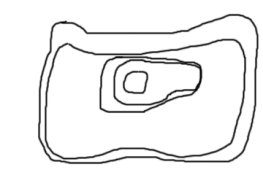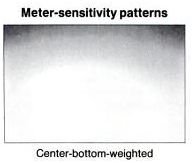An interesting discussion on the A-1 and since I was mentioned, I figured I should chime in. Pardon me while I blather on in reminiscence.
As to the A-1's metering pattern, I will defer to what is written in the manual. I no longer recall where I read that it had a bottom-centerweighted metering pattern, but that term has stayed with me for over 30 years. I just did a google search on it, and apparently I'm not the only one who thinks the A-1's metering pattern is bottom-centerweighted.
It was encouraging to read about the faithful, long time users, pro and amateur, who have used the A-1 with such good results. Me, I've always had more of a love-hate relationship with the camera. I bought my first A-1 after owning my first real 35mm camera, an AE-1, for barely a year. My attitude at the time was that, if a little automation was a good thing, the a LOT of automation would be great! Fantastic! And for a while, I was totally in love with it, but the honeymoon was a brief one. I found from brutal experience that I had to be more disciplined regarding what was taking place on the screen, light-wise, or else my slides would suffer from the results. But it was still capable of handling complexly lit subjects, as long as the lighting was diffuse enough not to hit the meter with any hot spots.
Still, after a few more months of using the A-1 almost exclusively in a variety of venues and situations, I just felt I that I was missing something important. And that something was the underpinnings of photography that the A-1 so brilliantly hid from view. So, after reading a brief review in
Modern Photography in a column where vintage gear was often discussed, and in which in this issue it was the FTb, I was fascinated by the old tech I was reading about. It occurred to me that maybe what I needed to do was take a big step
back, and that's what I did. I picked up a clean FTb and also at the same time a very nice FL 35mm f/2.5 (still one of my favorite 35mm lenses of all time), and I fell in love all over again, but for this time, the right reasons. I also began to truly learn about the craft of photography, using this simple, yet very complete tool. And as it turned out, one of the features of the FTb I liked the best was the way it metered a scene. I quickly became a big fan of the 12% rectangle, and I've been a big fan of it ever since. Hey, if it works, you stay with it. It worked, so I've stayed with it -- for over 30 years.
About a year later, I bought my first old F-1. It was a beater -- I mean, it looked like somebody had used it as a hockey puck. But it was stone-cold reliable and dead-on accurate and I proceeded to use it heavily. I liked it so much, I bought another one a couple years later, just so I could have two of the same camera with two different types of film, if I chose to.
All during this time, though, I kept my A-1, and I even used it. But by that point I'd learned my lesson with regards to its meter, so I relegated it to "safe use" environments, since I shot slides exclusively. The A-1's meter was always accurate, but its metering pattern wasn't capable of staying within a slide's narrow latitude range, so I always had to be cautious how I used it. In fact, some of my best photos ever have been taken with the A-1.
Canon A-1, Canon nFD 200mm f/2.8, Kodachrome 64:
Here's an example of a slide that my A-1 underexposed somewhat, because of all the bright sky. Still, because of the strong subject matter and tight framing, even if the backside and the trees are in silhouette, it worked okay. I dodged the bullet, IOW.
Canon A-1, Canon 50mm f/1.8, Fujichrome 400:
Ever since I took my lens off the "A" setting the very first time on my AE-1, I've felt that the A-series Canons were handicapped when it came to trying to use them in manual mode. To me, it was inconvenient and distracting, having to remove my eye from the finder to adjust and/or check the aperture value on the lens. And once I saw how smoothly it operated on the FTb and later the F-1, I rarely felt the need to shoot with my A-1 in manual mode after that. So once I had a good, manual exposure SLR, I just let my A-1's automation do its thing. Most often I chose Aperture Priority or Program for my automation preferences.
Although in certain situations, shutter priority was preferred. I shot motorsports for a number of years, and one of the things I quickly learned was, for pan shots, I had to keep the shutter speeds low in order to blur the background and the wheels of the car. Typically no faster than 1/125. 1/60 was a good speed to use, I found. It rendered a good, pronounced pan, but the camera was still generally hand-holdable. And when it wasn't I used a monopod, not a tripod, for stability.
1986 IMSA race at Riverside International Raceway. Canon A-1, Canon nFD 200mm f/2.8, Kodachrome 64

So to paraphrase what other members here have said, the A-1 is a tool, and you learn what you need to use the tool to its optimum. I'll freely admit that I lost patience with it regarding certain aspects of its feature set, but I still used it for those things it was good at. And why not? It was a valuable resource that I had had customized to my preferences (I had Canon replace the split-image/microprism focusing screen with a plain matte one, and ever since I bought a Motor Drive MA for it, the drive never came off. It had become a permanent fixture, which I most often used in single shot mode so I didn't have to remove the camera from my eye to advance the film.
I sold that A-1 when I made a brief switch from Canon to Nikon. And here it is, many years later, and I'm having to sell off A-1s because I've acquired too many. I'm keeping two -- one with the Motor Drive MA (of course) and the other without it. Which has left me with another three to get rid of. Why so many? *shrug* Not sure. Often they were part of an outfit and there was something in the outfit I wanted, so the A-1 came along with.
And why am I keeping two, you might be wondering, since I had this love/hate relationship and all. I dunno. Part of it is nostalgia, I'll admit. Part of it is fascination over the durable nature and longevity of this camera. I sometimes wonder if a camera maker had any idea that its products would last as long as they have. Heck, I got almost 25 years of use out of a first generation EOS Rebel for petes sake, and ended up selling it on eBay for twenty bucks, and chances are that plastic wonder is still going strong somewhere. So, yeah, I'd have to say that part of it is fascination -- perhaps even a bit of amazement -- that a camera like the A-1 has done so well over the years. That sort of track record speaks to volumes that few others can manage, or imagine.
And in closing regarding the disagreements here that appear to have become a bit too heated, I'm reminded of the old Fidonet -- a bulletin board network that existed in the dark ages before the WWW -- which had a rather famous slogan:
Be ye not overly annoying . . . nor too easily annoyed
I think folks here at apug comport themselves quite well by this sort of philosophy, whether they're aware of it or not.























